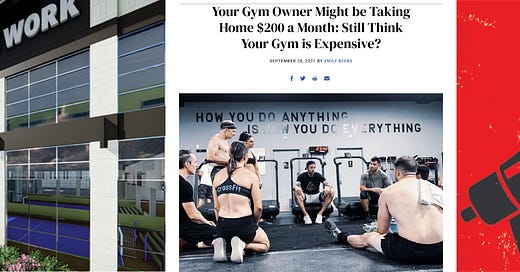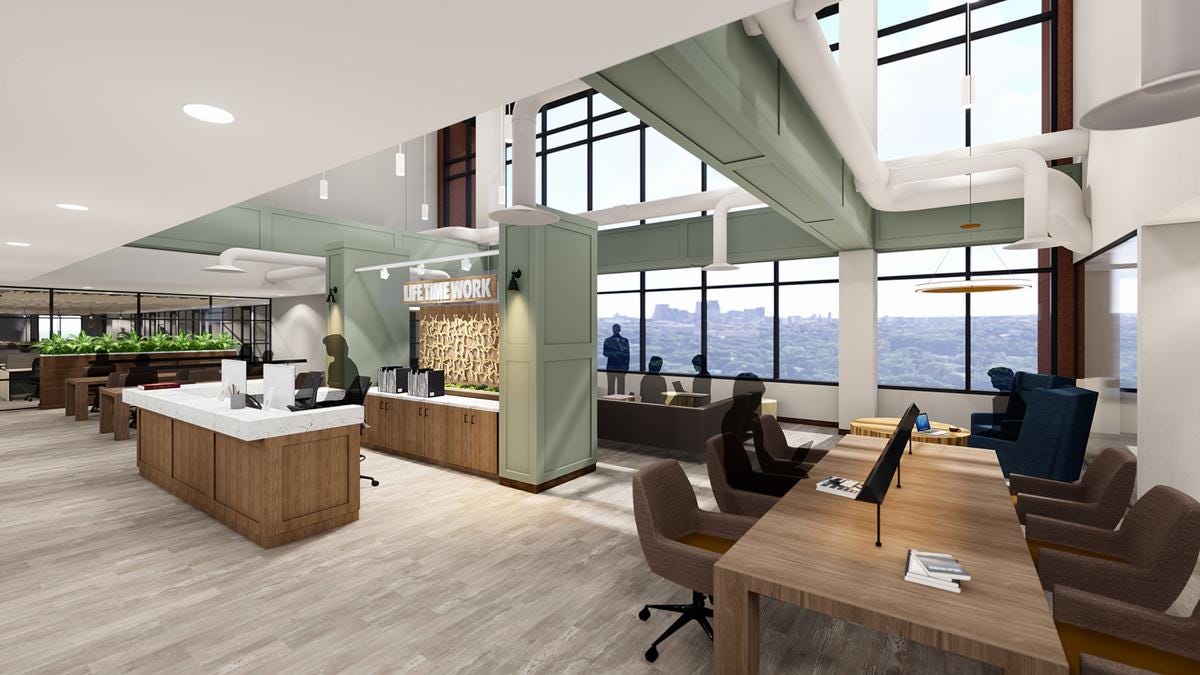Lift. Sweat. Move. Sip. Meet. Work. Repeat?
Can you maximize profits by creating a 'third-place'?
Back to our regularly scheduled publishing.
I just want to say thanks to everyone for giving me grace while I worked through our newsletter provider issues last week. We're back on schedule and excited to jam with you on today's topics.
Additionally, I stated that I'd be publishing video content about Using EIDL Money To Buy A Building or Other Wealth Strategies.
Here's the truth... video content has had a slight delay as the new studio has been under construction. But we are fully operational this week, so expect a video of this to drop on Friday via the YouTube channel - get subscribed if you're not already!
Keep doing what you can’t.
- Stu
Creating a 'Third Place' Within Your Microgym Is Gaining Traction Again.
I went all-in on this model and here’s why you might want to do the same…
You're probably familiar with Life Time, the uber-successful globo-gym brand out of Minneapolis, MN, that has been making a buzz in our industry as they just announced their second IPO (they were a publicly-traded company before, were bought out and went private, and now they are re-entering the public market).
Additionally, they just opened their latest Life Time Work location in downtown Minneapolis.
What is Life Time Work?
Well, think about what would happen if WeWork had a baby with a massive globo-gym.
Life Time Work provides members with personalized co-working spaces - including 100 private offices for two or more people, ten conference rooms, quiet rooms, private phone rooms, open meeting spaces, and outdoor rooftop patios.
Life Time Work opened its first location in April 2018 and has added ten more to the roster, with several still under construction.
Membership options include office resident, open resident, and lounge. All memberships include 24 hours a day access to the fitness facility and admission to all Life Time luxury health clubs in the U.S. and Canada.
MY TAKE
OK, so at the core of this article, we have a stupid-wealthy company building stupid-wealthy concepts in the fitness industry. Sure, it's cool and exciting from a macro-growth perspective for our sector, but that's not what intrigues me here.
My focus is on their investment in creating a "third-place" within their fitness facilities.
Third-place is a term used to describe where people spend time between home ('first- place) and work ('second-place’).
If you're a business nerd like me, then you're fully aware that Starbucks is the marquee example of a company with a B+ product, but built its success on an A+ experience - by creating the third-place.
Building a model that draws people into your building for more than your core service offering or product means more traffic, more awareness, and, ultimately - more customers.
While the third-place concept isn't new, the fitness industry has never been able to capture it at scale.
Many microgym owners have created small lounges or assembled cheap furniture to create some ballin’-on-a-budget-living room-hangout-social area in the corner of the gym.
Typically, these areas might be utilized at first, but generally die out over time.
Now you're left with sweaty couches and random IKEA furniture where people throw their gym bags- never really capturing that social third-place element that you probably dreamed of in your head.
Please know, I'm not judging these low-budget attempts at a third-place. Hell, I had them at my first two facilities back in the day.
But they didn't truly work. They didn't accomplish what they were designed to do.
So when I purchased my new building and created a new fitness brand, I knew my half-ass attempts wouldn't cut it anymore and decided to go all-in on this model by creating a place where you can workout and get work done.
At Urban MVMNT, we formed our third-place by building a social and work-friendly lounge and a full-service coffee shop.
*note: I didn't open a coffee company. I sublet to a coffee company. Remember kids, rental income is dope. Starting a business you have no business starting isn't.
Now I can activate my microgym from 5 AM until 8 PM with daily walk-in traffic, even when there are no group fitness classes.
The space created an opportunity for members to congregate before or after class, buy coffee, take business calls, fire off some emails, or socialize with friends.
And the organic leads from people coming in for their caffeine fix and having their curiosity piqued about that fitness thing in the back isn't too bad for business either ;)
But Urban MVMNT is not alone.
Several other microgyms have incorporated coffee shops or juice bars to increase traffic and create a third-place.
A few noteworthy examples include Academy of Lions, Built by Vitality, and Fight Zone.
So my question to you is this…
How do you plan to create a third-place within your microgym?
Or do you choose not to adopt the third place model and simply perfect your one core service offer?
Shoot me an email or DM me on the 'gram and let's discuss.
You own a gym and you’re broke.
Who is to blame?
The Morning Chalk Up team shares financial woes from a collection of microgyms owners in a recent article.
Essentially, taking the opinion that customers should think twice before complaining about the cost of their gym membership, because
The reality is the costs and time involved to own and run a CrossFit affiliate, or a small functional fitness gym, means many gym owners are putting in full-time hours and still aren't even coming close to earning a living wage.
Now, the Morning Chalk Up is a B2C publication, meaning their primary audiences are CrossFit customers and members of CrossFit gyms, not necessarily a B2B audience of business owners, which makes the entire positioning of this article a just little awk.
I understand they intended to educate CrossFit customers to the reality of these microgym owners P&L and try and help business owners get the message across to customers at scale, that, "Hey, I'm not charging enough for my services, so in the future, if there is a price increase, don't be too shocked, because you read about it in the Morning Chalk Up."
And while I get where they are going, the misalignment of their audience and the message of this article made for quite the spectator show in the comments of the associated IG post.
MY TAKE
1. Any shortcoming in your business is the owner's responsibility, not the customer's.
Emily Beers, the author of the article, is someone who I’ve had many conversations with and have contributed to several past MCU articles. So please don’t take this as a slam at her.
She’s doing good work and injecting business conversation into the mix of all the CrossFit fanboy pieces that keep MCU alive.
IMO, the entire article should have been positioned by directing the responsibility at owners, not customers.
Changing the narrative to "Hey, gym owner, if you’re tired of taking home $200 or less per month, raise your prices and do better." Aka the message that the failing microgym owners really need to hear because at the end of the day, if a business is failing - you need to point the thumb, not the finger.
2. Yes, most owners don't charge a profitable rate…but that’s not the only culprit here.
The core of the MCU article is accurate, with an exception.
I agree that "most owners don't charge a price that allows adequate profitability." However, as someone who is entrenched in the inner workings of this industry, I can assure you there are far more line items responsible for making a profit than simply not charging the correct rates.
Even if we selected all the owners and businesses from the Morning Chalk Up article and adjusted their rates to a market value that allowed for profitability, I’m highly confident their business issues would continue.
Because the majority of owners work hard. They just don’t work smart. It’s as simple as that.
If only there was a resource available for improve the business acumen of microgym owners, hmm…
3. It’s pure numbers - many owners just won’t make it.
CrossFit's grassroots nature empowered independent businesses to be more community-driven clubhouses than smart service businesses.
Everyone embraced a Kevin Costner "if you build it, they will come" mentality, and unfortunately, many still do.
But if you zoom out and look at the simple math of it, the CrossFit affiliate market is vastly bloated. And when that happens, you can count on one thing - many will fail.
These woes that the CrossFit owners are experiencing aren’t unique to them.
Did you know that there are over 40,000 independent pizza shops in the US?
And guess how many don’t make it? A fuck ton.
In fact, most don’t make it.
But that’s the game we play. So to write an entire article highlighting the obvious - that some owners suck at owning - shouldn’t really be news to anybody.
Now let’s have some fun.
Some candid responses from the comments section of the above mentioned article for your entertainment…
I’m not a big fan of internet arguing, but I have to admit - the 300+ comments that came through under the MCU article I referenced were fan-fucking-tastic.
So I figured let’s kick off your Monday by highlight a few of my favorite ones, with some commentary.
Enjoy.
Dear @kimbartee88,
Just cause you can, doesn’t mean you should. And in a town of 3,000, I recommend two things:
Move. Anywhere.
Stay a customer. You’ll be happier, have more money and won’t develop a jaded relationship with fitness like the owners who were quoted in the article.
Oh, @seanhaskell…
You’re not wrong. But I wish you were.
Next time you talk to one of these virtuous owners who repel profit so that their bestie-community-over-everything-friends-forever-kipdick clubhouse can stay alive, realize you’re talking to a human who is so deep into it, they don’t know how to escape.
You’re basically talking to someone who took themself hostage.
@rreyes3 got the mood lighting in his profile pic right, but that’s about it.
I’m not saying $3,000 isn’t a lot of money.
I’m saying $3,000 isn’t a lot of money to utilize a brand name that is worth $4,000,000,000.
You’re telling me you wouldn’t spend $250/mo to have your associated brand name all over clothing and shoes inside of every Dick’s Sporting Goods and on ESPN? #stopbeingacheapfuck
Hopefully they don’t involve salmon colored, half unbuttoned dress shirts.
First off, who the fuck puts a collage pic as their profile picture?
We can’t see all three of those fucking images. Please stop making me squint.
Second, I hate to hear that. It sucks. But I’ve got good news, @aofitness!
You’re completely in control to change it!
Isn’t that nifty?!?
So less sad-sad time on IG and more makey-makey money.
Great advice, @crossfitpeterborough.
I’m sure your landlord, employees and vendors will totally understand when you try to pay your obligations with love and passion.
Just let me know when you have to sell your equipment on Facebook marketplace. I need a new med ball.
And this fucking gem of a comment.
You’re right, @daveedyy. HIIT isn’t a trademark.
It’s a type of workout.
CrossFit™️ is a trademark. It’s a brand and a business.
Now let’s try another one together!
Burritos are not a trademark. They are a type of food.
Chipotle™️ is a trademark. It’s a brand and a business.
I think whatever the fuck is wrapped around your face is a bit too tight.
If you enjoyed this email, please make sure to share it with any other fitness professionals. I’m trying to help this industry not suck, one newsletter at a time.















